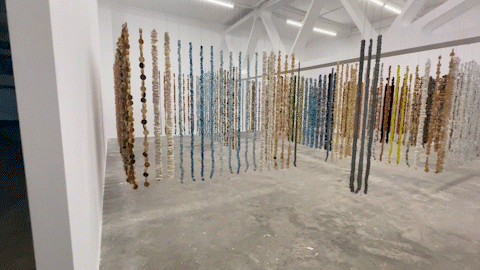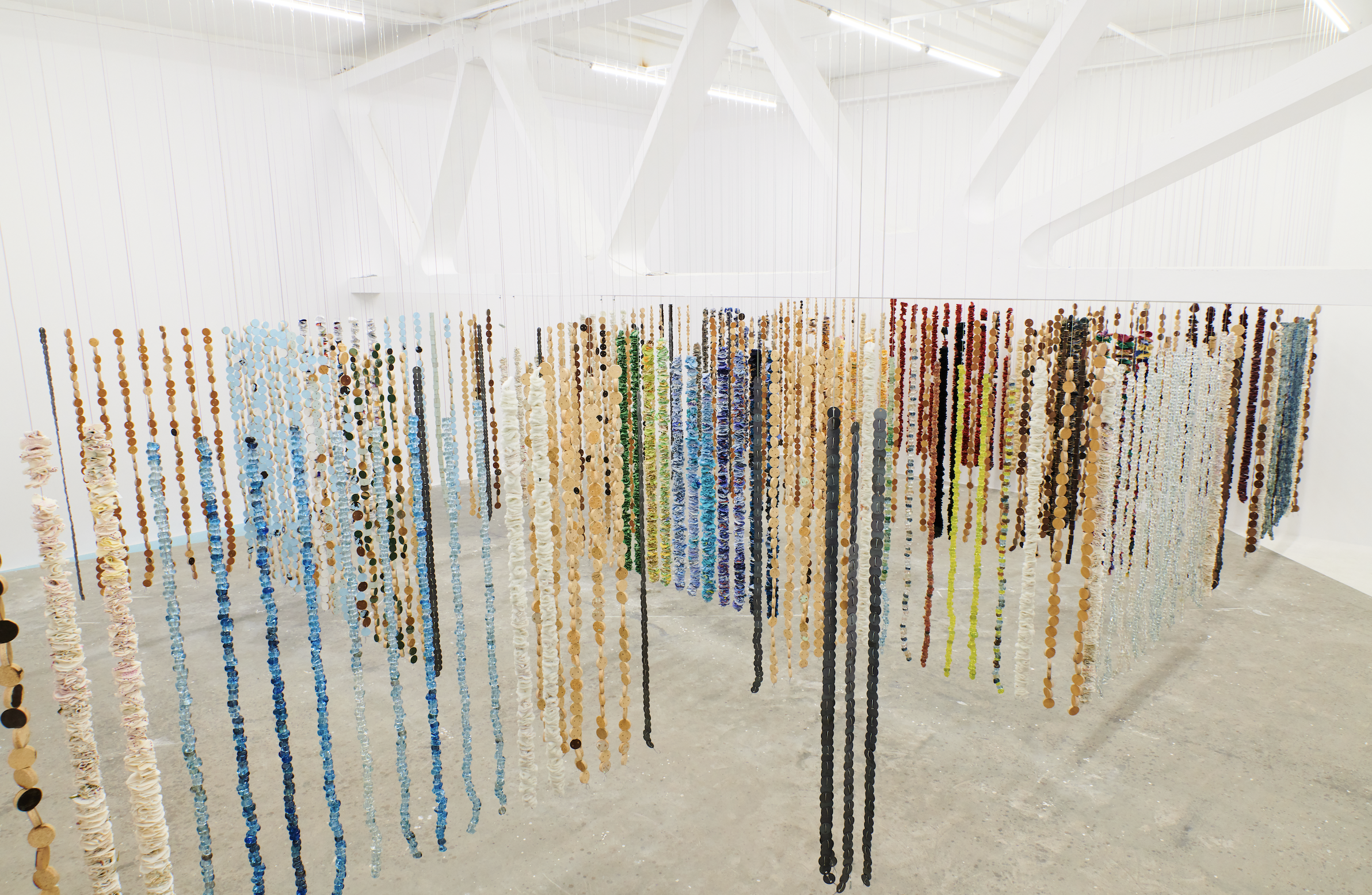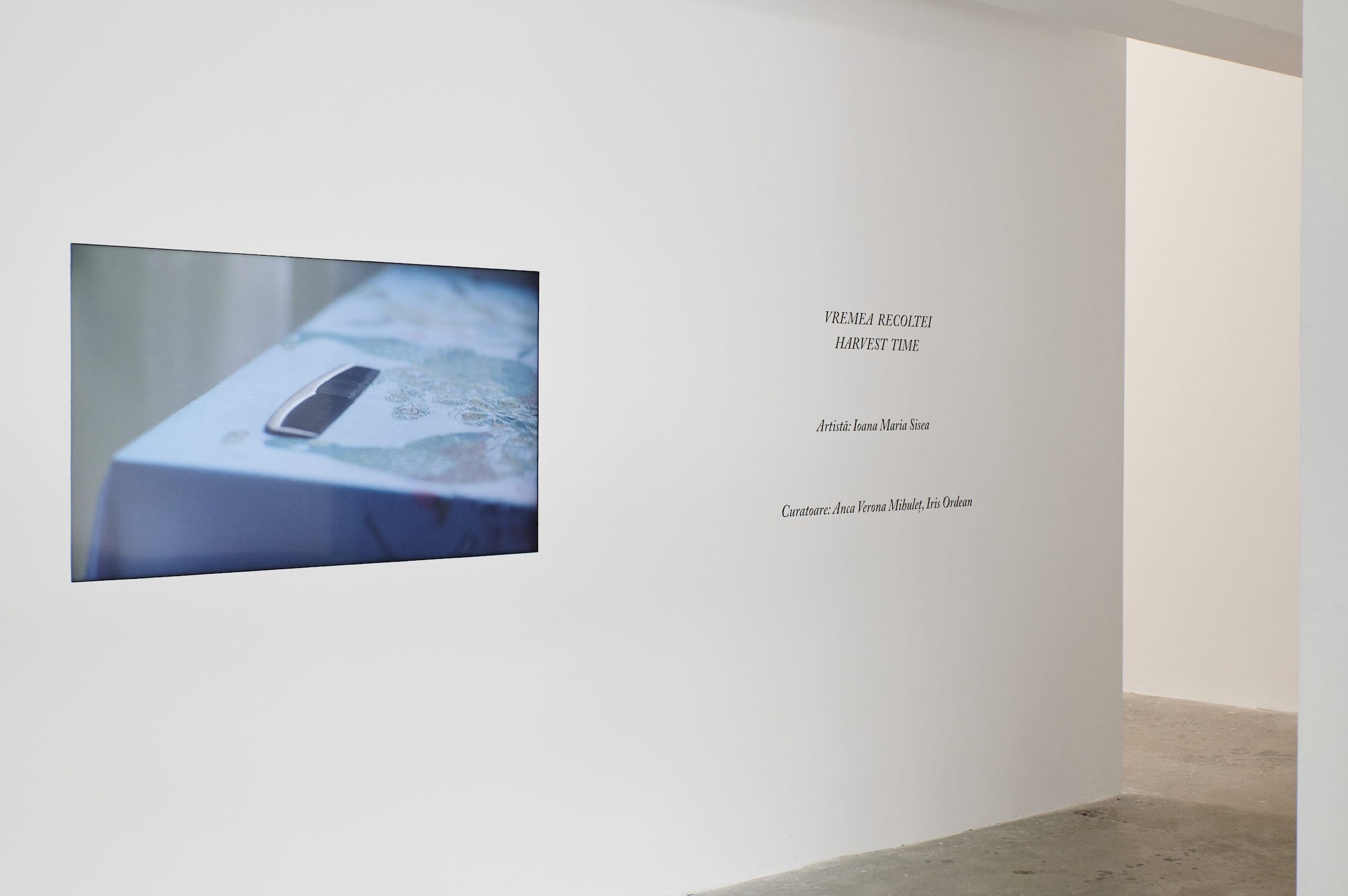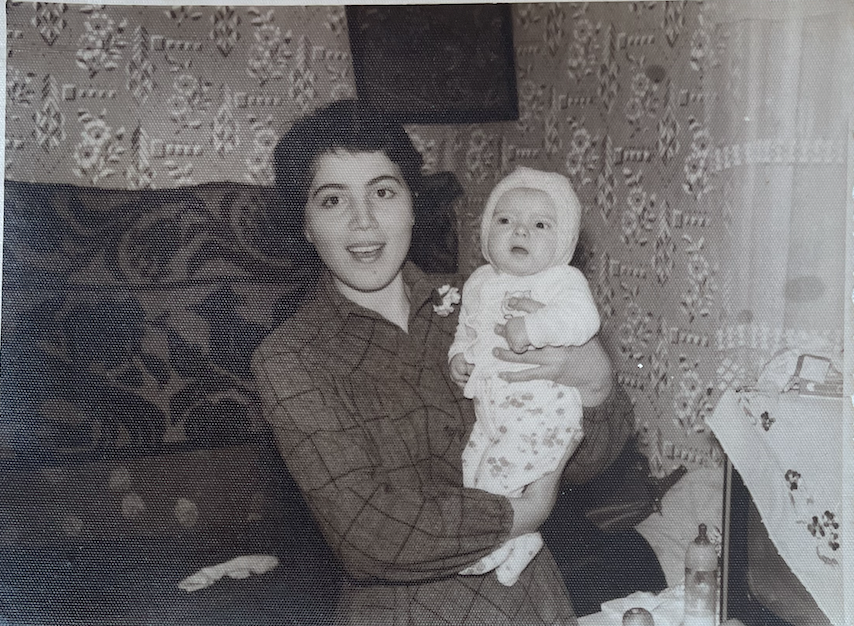Harvest Time
“My grandparents had a house, three beds, four tables, fourteen chairs, twenty-seven glasses, forty-four plates, three televisions, five carpets... My grandparents lived in one of the four rooms of the house; the other three were kept as a stage set that we couldn't touch. They were the good rooms to which only important people who came to visit, such as priests or more distant relatives, had access.”
This is a fragment of how Ioana Sisea remembers her maternal grandparents' house. There are no traces of nostalgia to be found, but we can speak about the responsability implied by memory that paves the way for an understanding of the poetics of a space known in depth over a long period of time, both from a material and formal perspective. Memory becomes, thus, almost a medium in itself, essential for its allegorical potential in the installation’s visual representation, in organizing an account of aesthetic preoccupations.With the death of her grandparents, Ioana's relationship with the house in which she grew up was transformed. The house itself became a spatial construct loaded with layers of memory; stripped of daily activities and the tension of the immediate, the house was embedded in a distinctly contoured personal geography. The absolute democratization of space was necessary to save the memory of place.
The title of the exhibition, Harvest Time, is a direct reference to the way in which in autumn, in Mediterranean regions or in some areas of Southeastern Europe, vegetables and fruit are often dried on threads of string and then hung from the ceiling beams or walls of houses. For Ioana, this association has a special significance, being a reference to the agricultural activities around her grandparents' house, but also a tribute to the processes that involve physical labour, both in art and in daily life. The installation speaks of the intimacy of lived memory through the magnifying glass. With the metaphor of harvesting, we are granted access to the artist’s universe, informed by subjective past experience. Socio-political memory makes way for the installation of the reflexive memory codifying art both cognitively and emotionally, through which an abstracted archive emerges, a Derridean place of commencement and commandment.
This is a fragment of how Ioana Sisea remembers her maternal grandparents' house. There are no traces of nostalgia to be found, but we can speak about the responsability implied by memory that paves the way for an understanding of the poetics of a space known in depth over a long period of time, both from a material and formal perspective. Memory becomes, thus, almost a medium in itself, essential for its allegorical potential in the installation’s visual representation, in organizing an account of aesthetic preoccupations.With the death of her grandparents, Ioana's relationship with the house in which she grew up was transformed. The house itself became a spatial construct loaded with layers of memory; stripped of daily activities and the tension of the immediate, the house was embedded in a distinctly contoured personal geography. The absolute democratization of space was necessary to save the memory of place.
The title of the exhibition, Harvest Time, is a direct reference to the way in which in autumn, in Mediterranean regions or in some areas of Southeastern Europe, vegetables and fruit are often dried on threads of string and then hung from the ceiling beams or walls of houses. For Ioana, this association has a special significance, being a reference to the agricultural activities around her grandparents' house, but also a tribute to the processes that involve physical labour, both in art and in daily life. The installation speaks of the intimacy of lived memory through the magnifying glass. With the metaphor of harvesting, we are granted access to the artist’s universe, informed by subjective past experience. Socio-political memory makes way for the installation of the reflexive memory codifying art both cognitively and emotionally, through which an abstracted archive emerges, a Derridean place of commencement and commandment.
There are many ways in which we can document private space – we can refer to the cosmological formula proposed by Gaston Bachelard in The Poetics of Space; or to the antagonism between pollution and purification explored by Mary Douglas as early as the 1960s; or to the key structuralist interpretation offered by Pierre Bourdieu in his study of Kabyle houses in Algeria, based on binary dichotomies: woman – man, inside – outside, birth – death; or more recently to Griselda Pollock's or Jane Rendell's theories of modernity and the gender of space.
Ioana has eliminated the borders imposed by walls and meticulously, she started to register and index all of the items which were found in her grandparents’ house at the moment it was inherited by the following generation, room by room, item by item, material by material. This activity turns the artist into a meditative archivist, working from and with reflexive memory, just like an agent. The disappearance of their users led to the abstraction of those possessions. Traditional documentation was continued by performative actions that sought to divide all the objects in the house into beads – glass and metal were melted and reshaped into spherical shapes, wood was fretworked into round elements, and textiles were hand-cut into circles.
Memory functions as a deconstructive and reconstructive performative agent simultaneously – two phenomena which are acting at the same time, similarly to the principle of action – reaction. That is to say, in addition to the immense affective labour the artist put into creating the work for almost five years, a more hands-on labour juxtaposes, one of literal deconstruction: melting, cutting, drilling through, adapting the working technique to the needs of each material. A deconstruction, piece by piece, of the former familial living and social habitus, as described by Pierre Bourdieu and Zander Navarro, transforming items which had formally contributed to the everyday lived experience of which she was a part of very often during her childhood: from chairs, beds, carpets, to house appliances, invoices, cups and glasses. Elements of everyday use sit together with the Sunday clothes, or the good cutlery.
Ioana has eliminated the borders imposed by walls and meticulously, she started to register and index all of the items which were found in her grandparents’ house at the moment it was inherited by the following generation, room by room, item by item, material by material. This activity turns the artist into a meditative archivist, working from and with reflexive memory, just like an agent. The disappearance of their users led to the abstraction of those possessions. Traditional documentation was continued by performative actions that sought to divide all the objects in the house into beads – glass and metal were melted and reshaped into spherical shapes, wood was fretworked into round elements, and textiles were hand-cut into circles.
Memory functions as a deconstructive and reconstructive performative agent simultaneously – two phenomena which are acting at the same time, similarly to the principle of action – reaction. That is to say, in addition to the immense affective labour the artist put into creating the work for almost five years, a more hands-on labour juxtaposes, one of literal deconstruction: melting, cutting, drilling through, adapting the working technique to the needs of each material. A deconstruction, piece by piece, of the former familial living and social habitus, as described by Pierre Bourdieu and Zander Navarro, transforming items which had formally contributed to the everyday lived experience of which she was a part of very often during her childhood: from chairs, beds, carpets, to house appliances, invoices, cups and glasses. Elements of everyday use sit together with the Sunday clothes, or the good cutlery.
To it, a reconstructive approach closely follows: the transformation of the contents of the grandparents' house into beads, which is part of a spatial progression and a re-production of meanings; the beads, typical of female representations, became the code for understanding the entire house. In this way, Ioana Sisea identified her childhood home with an eminently feminine, mobile universe.
In the context of the first presentation of the project in Kunsthalle Bega Box, strings of beads are placed side by side to create penetrable walls that depict the blueprint of the grandparents' house. Each bead wall is specific to a room, made from the divided objects that were once part of that room. Very few items survive the transformative process, testimonies of a former destiny anchoring the installation's past and present histories. The film showing the gathering of objects and breaking down of the furniture, together with two photographs from the artist's childhood, are the only helpful elements that allow the audience to imagine the evolution of that locus, as if the viewer was watching through the keyhole, catching quick glimpses of a reality which is now transformed forever.
Curators: Anca Mihuleț and Iris Ordean
In the context of the first presentation of the project in Kunsthalle Bega Box, strings of beads are placed side by side to create penetrable walls that depict the blueprint of the grandparents' house. Each bead wall is specific to a room, made from the divided objects that were once part of that room. Very few items survive the transformative process, testimonies of a former destiny anchoring the installation's past and present histories. The film showing the gathering of objects and breaking down of the furniture, together with two photographs from the artist's childhood, are the only helpful elements that allow the audience to imagine the evolution of that locus, as if the viewer was watching through the keyhole, catching quick glimpses of a reality which is now transformed forever.
Curators: Anca Mihuleț and Iris Ordean
2018-2022
Installation and video
Exhibited:
Kunsthalle Bega - Harvest Time - 2.09.2022 - 1.03.2023 - Timisoara, RO
Press:
https://kunsthallebega.ro/expozitii/vremea-recoltei/
https://www.igloo.ro/harvest-time-sau-conservarea-prin-distrugere-interviu-cu-artista-ioana-sisea/
https://www.mutualart.com/Exhibition/Ioana-Maria-Sisea--Harvest-Time/3BBC668D90724A6E
http://metropotam.ro/La-zi/harvest-time-ioana-sisea-a-deconstruit-casa-bunicii-si-a-transformat-o-intr-o-instalatie-superba-de--art5028104020/
https://revistaarta.ro/ro/vremea-recoltei-jocul-memoriei-intre-perisabilitate-si-persistenta/
https://www.iqads.ro/articol/63065/ioana-sisea-am-lucrat-4-5-ani-la-instalatia-vremea-recoltei-a-durat-mult-sa
https://contemporarylynx.co.uk/exhibition-review-harvest-time-at-the-kunsthalle-bega-in-timisoara
https://blokmagazine.com/a-little-stardust-caught-a-segment-of-the-rainbow/
https://jurnalul.ro/cultura/kunsthalle-bega-prezinta-expozitia-vremea-recoltei-908068.html
Installation and video
Exhibited:
Kunsthalle Bega - Harvest Time - 2.09.2022 - 1.03.2023 - Timisoara, RO
Press:
https://kunsthallebega.ro/expozitii/vremea-recoltei/
https://www.igloo.ro/harvest-time-sau-conservarea-prin-distrugere-interviu-cu-artista-ioana-sisea/
https://www.mutualart.com/Exhibition/Ioana-Maria-Sisea--Harvest-Time/3BBC668D90724A6E
http://metropotam.ro/La-zi/harvest-time-ioana-sisea-a-deconstruit-casa-bunicii-si-a-transformat-o-intr-o-instalatie-superba-de--art5028104020/
https://revistaarta.ro/ro/vremea-recoltei-jocul-memoriei-intre-perisabilitate-si-persistenta/
https://www.iqads.ro/articol/63065/ioana-sisea-am-lucrat-4-5-ani-la-instalatia-vremea-recoltei-a-durat-mult-sa
https://contemporarylynx.co.uk/exhibition-review-harvest-time-at-the-kunsthalle-bega-in-timisoara
https://blokmagazine.com/a-little-stardust-caught-a-segment-of-the-rainbow/
https://jurnalul.ro/cultura/kunsthalle-bega-prezinta-expozitia-vremea-recoltei-908068.html











